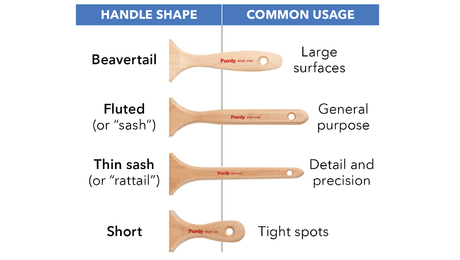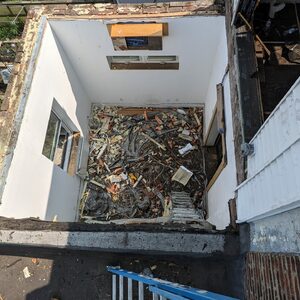*
Do I need to install a vent on a clawfoot tub? I am reinstalling the tub as part of a renovation. The tub is equipped with the traditional overflow tube directly under the faucet that connects directly to the drain below.
Thanks in advance for your comments.



















Replies
*
Yes, you need a vent. This tub is no different than any other. If you haven't changed any of the rough plumbing the vent should be in place. The trap would be under the floor connected to the drain and vent in the wall. If you have already changed the rough plumbing and have omitted the vent, you need to fix that. If you are anticipating changing the rough plumbing and don't even know that you need a vent, perhaps you should hire a plumber or get a good dyi plumbing book.
*
I'll think twice next time I thank someone in advance.
First, your arrogant "and don't even know that" response is unjustified. Though I make my living these days in the aerospace industry, I have substantial practical experience in the construction and design trades.
This project I speak of is a quasi-Queen Anne style house built in 1921. The house was built without a stack vent of any kind. I have added a proper stack vent and ran vents to each fixture. In fact, I've replaced the entire cast iron DWV system with new hubbed cast iron, except for the bathroom I write about.
Clawfoot tubs are not like other tubs. This particular tub is original to the house. These tubs are designed with a vent system integral to the drain. On a modern tub, a similar system is utilized for the purpose of overflow protection and to house the drain lever linkage. On the older tubs, this type of system was designed solely for venting and overflow protection. The vertical section of pipe is a cast 1 3/8" pipe, terminated with a right angle and a low resistance grate on the inside of the tub. Typically, a clawfoot tub of this era would have been installed without a seperate vent. Traps were installed in the same manner as they would be on tubs today.
From a physics perspective, a 1 1/2 modern vent added to this configuration will absolutely not aid in drainage. The short section of 1 3/8" vent pipe offers far less resistance than a long section of 1 1/2" snaked to a stack vent.
I realize what the code says. I am only trying to use some common sense in this design, since the tub will be installed against two plaster over brick walls, making it impossible to conceal a vent.
Of course, the vent system is also designed to allow fresh air to circulate. I realize that without a modern vent, the 6 foot horizontal run from the tub trap to the stack will not be subject to this type of ventilation.
Any practical, common sense advice would be greatly appreciated.
*
Hi PDennis,
Nice job of venting ;) It may not be to code, but common sense tells me that with only 6 feet to your stack, and the integral tub vent system you clearly described, your tub should drain perfectly fine...jim
*Ohhhh, it took me three readings to get that pun...Anyway, PDennis, let me know where you get your fixtures for the clawfoot tub. I have one source, but I would be interested in another. I also have a clawfoot tub, and the faucet leaks, I suspect from damaged washers and valve sets due to all the !@%&* grit in my water.
*PD,Mike is right, you do need a vent downstream from the trap to prevent siphoning. You may be able to add a flapper vent like mobile homes use, or your stack may be within the "critical distance".kk
*Your tubs "overflow vent" (not sure what else to call it) will only work as a vent if it is on the stack side of the trap. If it is on the stack side of the trap, it is a great place for sewer gasses to enter your bath room.And, PD, I think Mike's answer was a helpful one. I'm sorry he didn't know you were almost a pro. I see no arrogance in his reply.
*Overflow tubes are not unique to claw foot tubs. Virtually every tub is plumbed with a waste and overflow. The overflow does nothing more than the drain itself to relieve syphon suction on the trap since it is on the fixture side. A proper vent is required and necessary. If you still doubt that ask your building inspector. Depending on the size of your fixture drain you can locat the vent some distance from the trap. This is a "dirty arm" and 5' is allowed for 2" pipe. I don't recall off hand what is allowed for 1.5" pipe. If you need to locate the vent farther from the fixture you can increase the size of the "dirty arm".When I suggest that you don't know that a vent is required that is unnecessary arrogance. You seem to have made up your mind that a vent is not necessary and are looking only for justification of that oppinion, not "practical, common sense advice."
*Hey Bryan, a couple of sourrces for clawfoot tub stuff are: Antique Hardware & Home Store (www.antiquehardware.com) and Renovators (Conway, NH 800-659-2211) I'm in agreement with you Mike. The tub might drain, but it's not to code. A lot of code changed since 1920. (did they have code then?)
*Dennis,Try your local plumbing boutique. The one where I live sold me some fixtures made by a manufacturer called "Sign of the Crab". I bought a tub fixture (mine's pedestal, not a footed tub) that had the porcelain handles, a gooseneck faucet, and a telephone shower. They also had the oval ceiling-suspended rail for a shower curtain, and an upright shower for a cast-iron tub. They even made basin cocks (make up your own joke). There's a lot of stuff out there now that old-house restoration has become popular.
*PDennis, this is a site primarily for professionals.Both pro's and DIY's ask for advice, if you don't want short ,sweet and to the point advice on the correct and legal methods look elsewhere.How would you expect your local buildind official to answer your question on how to circumvent the codes?I didn't see anything but good advice on where to find a schematic of plumbing vents.I am a carpenter who does remodeling,that means the plumbing and electrical reference books go in the van to the jobsite with me.And before anyone asks if this is how I speak to my customers...YES it is.Straight forward and directly.99% of the time when I'm accessing a job with the homeowner, there is only one building professional present!
*
Thanks Mike and all. I'll work a legitimate vent into the design one way or another. And I appreciate all the pros who are more than willing to assist a non-pro.
As far as sourcing fixtures for the tub, i'm still working on it. I actually purchased a faucet and shower ring from Renovator's Supply and got very screwed. I wound up sending it all back. I won't get into gory details here, but anyone who would like more information can e-mail me directly at [email protected]. (Had i checked Breaktime first, I would've seen the negative feedback regarding Renovator's!)
For smaller items, I've used Restoration Hardware (restorationhardware.com) with good results. They have a decent collection of reproduction towel bars, lighting fixtures, and other non-plumbing bathroom fixtures. They also have a number of retail outlets, so you can test drive everything.
For re-chrome, the tub feet on one of my tubs were done by Harley Davidson, and they did a great job, at half the price of new.
*
If we use some common sense we will realize that, contrary to popular opinion, the sole goal of building officials is not to make builders lives difficult. The sole goal of building officials is to retire with a good pension and benefits. Since, they are not self-employed they stand a fair chance of realizing this goal. There is not a large market for self-employed building officials, although, some do make money on the side helping contractors through difficult situations, like failure to put rebar in the concrete. Building officials must be doing well at these side jobs since they drop a lot of hundred dollar bills on job sites and, if it weren't for the alertness of contractors, wouldn't even notice them there on the ground.
So the big threat to building officials retirement plans is not self-employment, but it is job security. Therefore to protect their retirement they write building codes. They can't very well just write a code that guarantees them retirement and then go home and wait til they're 65 and start collecting, so they make up some arcane rules that only they understand, such as plumbing vents.
The best way for a contractor or diyer to deal with this situation is help the building inspector find his or her lost hundred dollar bills. Another alternative is to install the questionable component and then remove it after the inspection. This works with totally unnecessary stuff like vents and rebar, but should not be attempted with floor joists, trusses or sheeting. This second method is seldom cost efficient except on tracts where the removed components can then be installed on the next unit for its inspection and so on.
*If you don't want a vent! Don't put one in! How ever you should put on in! L. Siders
*
Do I need to install a vent on a clawfoot tub? I am reinstalling the tub as part of a renovation. The tub is equipped with the traditional overflow tube directly under the faucet that connects directly to the drain below.
Thanks in advance for your comments.